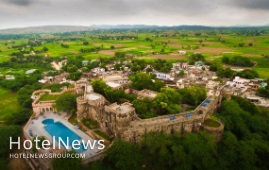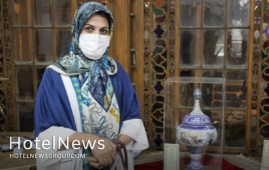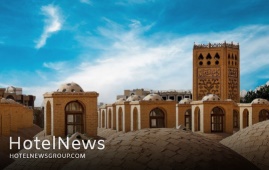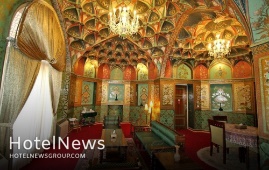
Historic hotels around the world you must add to your buncket list Alfonso XIII Hotel - Spain Alfonso XIII Hotel is one of the most beautiful 5-star hotels in Spain, which was built in 1928. The hotel has 151 luxurious rooms with full facilities; 19 single rooms 55 double rooms 55 duplex rooms 22 royal suites for families with many children. This hotel has 3 restaurants, the main restaurant called San Fernando is located in the central courtyard of the hotel and serves classic Spanish dishes and wines. Ena Sevilla restaurant is located on an open terrace and pricents a view of the city center and serves a variety of tapas and cocktails. The poolside restaurant also serves variety of snacks and fruit drinks. This hotel also has spa facilities, sports club and swimming pool.
Create: Oct 22, 2022 Edit: Oct 22, 2022 TV
Historic Hotels Around the World you Must Add to your Bucket List Hotel Hill front kesroli - India The 14th century Hill Fort-Kesroli is one of the oldest heritage sites in India The reservation of the rooms of this hotel is done only through the online reservation system, and guests can contact the hotel directly to book the room Only when they want a reservation for the same day. There is no TV in the hotel rooms and there is no room service. In the hotel restaurant, Indian dishes are served along with dishes from other continents to suit most tastes. Also, French, Italian, Chinese and Thai dishes are offered to complete the poolside restaurant buffet. This hotel is an ideal base for visiting the palaces, museums, natural sites and sanctuaries of Sariska and Alwar.
Create: Oct 22, 2022 Edit: Oct 22, 2022 TV
Hotels that we look forward to their exciting opening in 2022 Part 1 CONRAD TULUM RIVIERA MAYA Hotel in Mexico🇲🇽 The hotel is the newest luxury addition to the Hiltons hotels portfolio CONRAD is known for its contemporary style the modern design sets the brand apart from waldorf astoria hotels and symmetry is key element at this particular property hotel. Rooms are arranged in several buildings along the shore line and at the topmost floor, the view of the sea is spectacular The hotel boasts five different restaurant. The main pool bar is the centerpiece of the hotel and in the evening the guests can enjoy drinks while listening to live music or dj performances Guests have multiple options of getting around the hotel they can order a golf car, take a bike or walk along the jungle paths The gym located in the basement of the hotel, yoga and spinning classes are offered throughout the week
Create: Oct 22, 2022 Edit: Oct 22, 2022 TV
Arabian, who is a master of metalwork and Minakari (enamel), participated in the event with one of her exquisite works, a lavishly-decorated metal bowl designed for serving gaz (nougats with pistachios and almonds), CHTN quoted Vida Tavahodi as saying on Friday. Minakari is an ancient art of painting natural motifs such as flowers and birds on the surface of metals, mostly copper. Due to the outbreak of the coronavirus, the event was held virtually in India, but the artist will soon be awarded the prize at a ceremony, the official added. The award for the Male Craftsperson of the Year went to Dalavayi Kullayappa from India, while Zohra Said from Morocco and Ismael Arturo Rodriguez Moreno from Mexico named Female Craft Designer of the Year and Male Craft Designer of the Year respectively. ICA is organized by Craft Village, a social organization, based out of New Delhi, India, working towards training and promotion of handicrafts. ICA sets a new benchmark in the world with the highest level of skill and design excellence. The awards provide an open platform for makers working in a wide variety of materials and media to have their work assessed by a professional jury and international craft experts. These awards promote, inspire and encourage talent of the highest standards, making International Craft Awards an annual global feature. With 14 entries, Iran ranks first globally for the number of cities and villages registered by the World Crafts Council, as China with seven entries, Chile with four, and India with three ones come next. In January 2020, the cities of Shiraz, Malayer, and Zanjan and the village of Qassemabad were designated by the WCC- Asia Pacific Region, putting Iran’s number of world crafts cities and villages from ten to 14.
Create: Jan 15, 2022 Edit: Jan 15, 2022 Regional News
Wyndham Hotels & Resorts, the world’s largest hotel franchising company with approximately 9,000 hotels across nearly 95 countries, continues to expand its global footprint with its entry into Poland with the 205-room upscale Wyndham Wroclaw Old Town. Managed by Mogotel Hotel Group, a leading hotel operator in the Baltics, the property is expected to open early next month and will be located in the heart of Wroclaw’s city center. One of the largest cities in Western Poland and home to many renowned universities and research centers, Wroclaw combines rich history and charming architecture with a lively cultural scene across its museums, theatres, art galleries and workshops. Perfectly positioned for exploring the central, picturesque Old Town with many attractions and landmarks, the hotel will feature stylish guest rooms, an expansive atrium and a top floor wellness area, with a state of the art fitness room, sauna and steam bath. The hotel will offer a wide range of food and beverage outlets including a gourmet restaurant, a cozy lounge and bar to relax and socialize. Those traveling for business will also have access the hotel’s 11 meeting rooms, which accommodate a total capacity of over 400 attendees. In addition, the hotel is conveniently located just 10 miles from Wroclaw’s International Copernicus Airport. Wyndham Wroclaw Old Town is the latest addition in Wyndham Hotels & Resorts growing portfolio in Europe, including over 350 operational hotels across 30 countries and a development pipeline of over 90 properties. Wyndham hotels in Poland and around the world participate in Wyndham Rewards, the world’s most generous hotel rewards program with more than 50,000 hotels, vacation club resorts and vacation rentals worldwide.
Create: Jan 11, 2022 Edit: Jan 11, 2022 International News
Menus are an important aspect of the overall presentation of a hotel restaurant. Indeed, a whole book on proper menu design could be written, with inventory arrangements, fonts, graphics, spacing, types of paper, menu backings and all other stylistic concerns outlined as contributing factors for a guest’s overall appreciation of the dining outlet. The pandemic has thrown a wrench in this marketing and sentiment-boosting tool as many customers now expect menus to be accessible on their phones via a QR code. The benefit for the restaurant is certainly there in the form of saving on printing costs, but it’s nonetheless a tradeoff. The concern that we have over the proliferation of QR menus is that they don’t build guest satisfaction as much as their physical antecedents, and this reduced sentiment can halo back onto room revenues in a negative way. Here’s why: paper is palpable. You feel the slight roughness of a thick paper stock, subtly smell the ink, are delighted by the way the room’s lighting creates soft shadows on the page and are soothed by (what we ideally hope that you would use for your establishment) the touch of the leather menu backing on the palm of your hand. Viewing a menu on your phone gives you none of that. Yes, you get graphics, color and the ability to keep the webpage updated in real-time as inventory changes, but everything beyond the straight visuals are lost in the endless scroll of a two-dimensional screen. And building on this notion of scrolling, one critical difference is that a physical menu presents all items together for readers to consider, whereas a responsive webpage (over simply displaying a PDF version of the menu) will usually configure all items into a single column so as to keep everything legible and to avoid lots of pinching. This second drawback is one of perception, where a narrowly focused column on one’s phone can increase the observed length of the menu, resulting in patrons ‘dropping off’ before perusing the entirety of it. We see a similar trend in website readership where it falls precipitously after around the first quarter of an article or page. In sum, on digital-first menus, you have to put your most expensive items (or highest margin) items at the top or they will likely be missed. At this point, with the end of the pandemic still very much a question mark, optionality and fitting your theme is what works best. Paper menus should be readily presented at high-end restaurants so that the theme is congruent and customer satisfaction isn’t deteriorated, while at more casual settings a QR code access may be just fine. While there are both paper and labor costs associated with QR menus, you must still consider the above downsides.
Create: Jan 1, 2022 Edit: Jan 1, 2022 F and B
After years marred by a global public health crisis, many of us are lapping up in-person social gatherings with friends, family and colleagues. Morning catch-ups over coffee, afterwork happy hour at the favorite waterhole or weekend drinks in town had mostly been replaced with coffees-to-go, virtual apéros, or alfresco drinking in winter like in summer. Consumers have become today their own baristas and bartenders, imbibing alone at home or at a distance outside. So how, and with what, will we quench our thirst? Here is EHL’s selection of the top drink trends in 2022. In this pandemic-era, there is no doubt that the megatrends for the new year will center around healthier and ‘cleaner’, more sustainable, premium and socially responsible products in line with the mantras – good for me, good for the planet – and quality over quantity. With movements like mindful drinking and “sober curious” gaining popularity, research indicates that alcohol consumption has declined with younger generations drinking less as they show greater interest in holistic wellness and health. And the beverage industry has been paying attention to these shifts in concern, consciousness and habits. Functional and healthy beverages are on the rise, and no and low alcohol ready-to-drink offerings from North America to Europe and Asia-Pacific have boomed as they prove to be both a more convenient and ‘safer’ option in a world still plagued by COVID-19 measures and barrier gestures. But globally, we’re seeing an array of interesting new product developments, packaging innovations and surprising mergers and acquisitions with the lines between the health movement, the low- and no- alcoholic category and the wider drinks industry becoming increasingly blurred. Beyond these general tendencies, we take a look at six particular drink trends for the year ahead. 1. CBD-infused relaxation drinks For those of us who frequent trendy bars, a controversial yet very 2022 new trend has found its way onto cocktail menus in only the most avant-garde of venues. 2. The bubble tea craze goes global Despite being invented in the 1980s, bubble tea is set to see its popularity soar to new heights. From the US to Germany, China to Brazil, the bubble tea industry is going global with its market expected to grow by almost $2 billion to reach $4.3 billion by 2027. The refreshing Taiwanese tea-based drink with its tapioca or fruit jelly ‘bubbles’ is appealing to health-conscious individuals enjoying the healthier variants low in sugar, with organic soya milk, green tea or fruity mixes as well as a younger generation seduced by its 200 or so different flavor combinations and even more customizable options making for a truly unique, tasty and fun drink. 3. Fermented drinks as a health-booster Increased awareness on the importance of fueling our body with quality and nutritious food and drink is driving a rapid growth in fermented beverages, occupying a significant portion within the functional and healthy drinks category. It’s estimated that probiotic beverages are expected to achieve over $77 billion in sales by 2025, almost double the revenue generated worldwide in 2018. While kombucha has been topping the leader board for some years, it’s now got some serious competition. Water kefir, with its more diverse probiotic strains shown to help boost the immune system and aid digestion, is gaining momentum and creeping into the mainstream. As is the fermented Mexican soda Tepache – another healthy, flavorsome, sustainable alternative to kombucha. While not new in itself, it has promising prospects in this ‘health-conscious’ era, but hey, it’s just a gut feeling! 4. Wines and champagnes with star power Celebrity beverage endorsements are nothing new. Think George Clooney and Nespresso, Jennifer Aniston and Smart Water, or countless sporting stars endorsing energy drinks. But expect to see more and more vineyards and champagne houses partnering with big names to capitalize on their glamorous images and extend their respective brand portfolios. After John Legend, Kylie Minogue or Brad Pitt, Cameron Diaz is the latest celebrity to venture into the wine business with her “clean” wines. The range comprises of an organic and vegan French rosé and Spanish white with no added sugar, with Diaz tapping into both the wellness trend and that of the growing ‘thirst’ for ‘pink’ wine. Such partnerships are also strategic in helping introduce wines and champagnes to new consumers, in particular millennial drinkers drawn to celebrity and wellness lifestyles, and who aren’t impartial to the Instagrammable aesthetic of a fizzy or rose-tinted drink. 5. Boxed wine as a sustainable (and sanitary) choice Did you know that during the COVID-19 pandemic, bag-in-a-box wine was the supermarket alcoholic “go-to” beverage? The draw? Beyond the product within the bag, boxed wine is easier to store, it better preserves open wine, and is proving a more hygienic and sustainable option, in particular for restaurants. With each three-liter box generating about half the carbon dioxide emissions to that of a glass bottle, boxed wine is also cheaper to transport, stock and more environmentally-friendly. Something that even the more premium wine houses can’t ignore. While wine connoisseurs may jump to the conclusion that boxed wine equates to poor quality, industry experts are suggesting that that’s changing, and fast, as sales are forecast to continue surging around the world in 2022. 6. Canned cocktails with premium products While some may have enjoyed following online mixology tutorials to create their own home-made cocktails, many long for the days when original creations were served ready-made for immediate consumption. Well, spirit brands and hotel chains like the Marriott have wasted no time to offer the perfect solution and create a variety of delicious, bartender-quality, ready-to-drink cocktails in cans. Tipped to be the hottest trend in the alcoholic beverage space in 2021, the development of prepared cocktails-to-go has, according to Nielsen Premium Panel data, accelerated 171% in 2020, and shows no signs of slowing down in 2022. With high-quality ingredients, authentic flavors, options between low-calorie, sugar and alcohol or premium spirits, and convenient and sanitary packaging – grab-and-go cocktails are here to stay. 7. Spiked sodas and alcohol-free beers and spirits With interest in low and no alcohol by volume (ABV) drinks skyrocketing over the last few years, more and more people are looking for a middle ground between tee-total and drinker, between functional and indulgent, between high-quality and convenience. Consequently, low and non-alcoholic beverages are flooding the market and is the space to watch. From non-alcoholic beers and premium mocktails by spirit brands to the boom of hard seltzers now spilling over into hard coffees and kombucha – consumers are going to be spoilt for choice. Whether it’s wanting something with less sugar and alcohol, with premium products, looking for a slight ‘kick’ in traditional non-alcoholic beverages or an alternative to beer, this growing category ensures there’s something for every taste bud and type of drinker. Drink trends 2022: a toast to good health As we look to turn our backs on 2021, and raise our glasses to a new year, the question still lingers as to whether the drinking habits developed in a COVID-era will prevail in a post-pandemic world. While there is still so much uncertainty, what is clear is that the increasing consumer interest in health, wellness and mindfulness is shaping the beverage industry as a whole as it seeks to quench this thirst for holistic balance. For being able to choose alcohol-free beverages without having to sacrifice flavors, fizz or authenticity. For indulging in a drink without having to abstain completely. For a return to more simplicity with natural and ‘clean’ products. For drinking less in quantity but better in quality.
Create: Jan 1, 2022 Edit: Jan 1, 2022 Coffee Shop
Hyatt Place Zurich Airport The Circle, the third Hyatt-branded hotel and the first Hyatt Place branded hotel in Switzerland, is officially open, expanding the Hyatt Place brand’s footprint globally in markets that matter most to guests and World of Hyatt members. The new hotel features the Hyatt Place brand’s intuitive design, casual atmosphere and practical amenities, such as free Wi-Fi everywhere and 24-hour food offerings. Because Hyatt’s efforts are grounded in listening and fueled by care, Hyatt Place hotels combine style, innovation and 24/7 conveniences to create an easy-to-navigate experience for today’s multi-tasking traveler. Hyatt Place Zurich Airport The Circle is situated in the Circle destination and directly linked to Zurich Airport, representing one of the most central locations in Switzerland. Guests can conveniently enjoy the business and lifestyle offerings of the Circle, which includes shops, restaurants, a park, airport facilities and The Circle Convention Center. After a productive day, guests can unwind in the park or take advantage of the great outdoors, as the Swiss Alps and Lake Zurich are nearby. Hyatt Place Zurich Airport The Circle offers: - 300 spacious guestrooms with separate spaces to sleep, work and play, as well as a Cozy Corner sofa-sleeper - The Market serving a selection of perfectly packaged grab-and-go items from snacks to salads as well as beverages available 24/7 - ZOOM Restaurant with all-day dining and take-out options, delivering responsibly sourced, regionally inspired fare as well as international classics, including small bites such as wraps and waffles and heartier options including salads, burgers, fries and Zurich specialties - Necessities program for forgotten items that guests can buy, borrow or enjoy for free - Free Wi-Fi throughout the hotel and guestrooms - Convenient Workspaces and Event Spaces including a communal table in the lobby and over 30,000 square feet (2,800 square meters) of function space at The Circle Convention Center - Fitness Center open 24/7, featuring cardio equipment with LCD touchscreens, along with the nearby park offering outdoor jogging and walking
Create: Dec 29, 2021 Edit: Dec 29, 2021 International News
Authorities of Persepolis have launched an unmanned aerial vehicle (UAV) documentation project to help study and analyze the neighboring lands and properties, which encircle the UNESCO World Heritage site in southern Iran. “A documentation project has been commenced on the closest boundaries of Persepolis to gather needed information to monitor possible changes and interventions in this area,” said Hamid Fadaei, the director of the World Heritage site. The first purpose of this documentary is to prepare a cadastral map of agricultural lands in the first-grade boundaries of Persepolis, and the second purpose is to record the current status of historical monuments, including historical sites and hills that are dotted in that area, Fadaei explained. “In that regard, we operate close-range photogrammetry and UAV in the documentation of architecture monuments…..And the project is expected to become to an end by the yearend (March 20, 2022),” the official noted. Persepolis, also known as Takht-e Jamshid, whose magnificent ruins rest at the foot of Kuh-e Rahmat (Mountain of Mercy) is situated 60 kilometers northeast of the city of Shiraz in Fars province. It was the seat of the government of the Achaemenid Empire, though it was designed primarily to be a showplace and spectacular center for the receptions and festivals of the kings and their empire. Persepolis ranks among the archaeological sites which have no equivalent, considering its unique architecture, urban planning, construction technology, and art. This 13-ha ensemble of majestic approaches, monumental stairways, throne rooms (Apadana), reception rooms, and dependencies is classified among the world’s greatest archaeological sites. The city’s immense terrace was begun about 518 BC by Darius the Great, the Achaemenid Empire’s king. On this terrace, successive kings erected a series of architecturally stunning palatial buildings, among them the massive Apadana palace and the Throne Hall (“Hundred-Column Hall”). According to Britannica, the stone was cut with the utmost precision into blocks of great size, which were laid without mortar; many of them are still in place. Especially striking are the huge columns, 13 of which still stand in the audience hall of Darius I (the Great; reigned 522–486 BC), known as the Apadana, the name given to a similar hall built by Darius at Susa. There are two more columns still standing in the entrance hall of the Gate of Xerxes, and a third has been assembled there from its broken pieces. Narratives say that Persepolis was burnt by Alexander the Great in 330 BC apparently as revenge to the Persians because it seems the Persian King Xerxes had burnt the Greek City of Athens around 150 years earlier.
Create: Dec 29, 2021 Edit: Dec 29, 2021 Regional News
New legal boundaries have been defined for five historical properties, which are scattered across Yazd province. The Ministry of Cultural Heritage, Tourism, and Handicrafts has announced the exact legal boundaries of the properties in separate letters to the governor-general of the central province, IRIB reported on Tuesday. In addition to protecting historical sites, the demarcation projects are aimed to prevent further destruction and damage. Esfahanian Garden House, Eqbal Factory, Vazir Castle, Ezzatabad Castle, and Ezzatabad Kushk (small garden pavilion) are those demarcated recently. In July 2017, the historical structure of the city of Yazd was named a UNESCO World Heritage. Wedged between the northern Dasht-e Kavir and the southern Dasht-e Lut on a flat plain, the oasis city enjoys a very harmonious public-religious architecture that dates from different eras. Yazd is usually referred to as a delightful place to stay, or a “don't miss” destination by almost all of its visitors. The city is full of mudbrick houses that are equipped with innovative badgirs (wind catchers), atmospheric alleyways, and many Islamic and Iranian monuments that shape its eye-catching city landscape. It is a living testimony to the intelligent use of limited available resources in the desert for survival. Water is brought to the city by the qanat system. Each district of the city is built on a qanat and has a communal center. The use of earth in buildings includes walls and roofs by the construction of vaults and domes. Houses are built with courtyards below ground level, serving underground areas. Wind-catchers, courtyards, and thick earthen walls create a pleasant microclimate. Partially covered alleyways together with streets, public squares and courtyards contribute to a pleasant urban quality. The city escaped the modernization trends that destroyed many traditional earthen cities.
Create: Dec 29, 2021 Edit: Dec 29, 2021 Regional News
The occupancy rate of hotels in Iran has reached 45 percent, the head of the Iranian Hoteliers Association has announced. Following the planned measures, the occupancy rate of the country's hotels, which had fallen below five percent because of the outbreak of the coronavirus, has reached 45 percent over the past three months, IRNA quoted Jamshid Hamzehzadeh as saying on Sunday. Multiple problems, notably the pandemic, caused a severe impact on the tourism industry, the official explained. Even before the coronavirus outbreak and in 2019, travel was reduced due to heavy rains and flooding across the country, and the hotel industry had to recoup nearly 100 percent of the costs paid for canceled hotel reservations, he added. The Iranian hoteliers have lost 220 trillion rials (about $740 million) over the past two years, he noted. However, some problems have been resolved and the hotels’ condition has improved, he mentioned. Back in October, the official announced that Iranian hotels are ready to receive foreign tourists as the issuance of tourist visas and the flow of foreign tourists from land and air borders would be resumed. Ninety percent of the hotel staff have been vaccinated against the coronavirus, so the hotels are ready to welcome foreign tourists, observing strict health protocols, he said. The main destinations of foreign tourists in Iran are specifically cities such as Mashhad, Qom, Tabriz, Shiraz, Yazd, and Isfahan, and to return to the figure of over eight million incoming tourists before the outbreak of the coronavirus, serious planning is required, the official added. Iraqi tourists will flood the country once the borders open, but attracting tourists from Europe will require some time, he noted. However, he noted that two-thirds of the hotel staff have lost their jobs, he added. Back in September, Hamzehzadeh announced that all employees of accommodation centers across Iran are scheduled to be vaccinated against the coronavirus. “To vaccinate staffs of all accommodation centers, including eco-lodges, apartment hotels, and guest houses, as well as hotels, more coordination with the Ministry of Health is needed,” he added. Back in July, ISNA reported that the tourism industry of the country has suffered a loss of some 320 trillion rials ($1.1 billion) since the outbreak of the coronavirus pandemic. The pandemic has also ruined more than 44,000 jobs in a once budding travel sector of the country, the report added. Experts believe accommodation centers suffered the most as a result of the outbreak of the coronavirus in Iran and its subsequent unemployment and financial losses. Months of steep recession has taken its toll. Many travel insiders, hoteliers, and tour operators have faced big dilemmas such as bankruptcy, unemployment, debts, and the prospects of not being competitive on the international level. Panels of travel experts have mapped out new marketing strategies hoping Iran’s tourism would get back on its feet once again. For instance, the Head of the Iranian Tour Operators Association has said the international tourist flow to Iran will return to normal until 2022. Iran is potentially a booming destination for travelers seeking cultural attractions, breathtaking sceneries, and numerous UNESCO-registered sites. Under the 2025 Tourism Vision Plan, Iran aims to increase the number of tourist arrivals from 4.8 million in 2014 to 20 million in 2025.
Create: Dec 28, 2021 Edit: Dec 28, 2021 Regional News
Cambria Hotels, an upscale brand franchised by Choice Hotels International, Inc. (NYSE: CHH), continues to expand around the country with the official start of construction on the Cambria Hotel Niagara Falls. This is the fourth hotel to break ground in Q4 2021 and tops off a year of growth across the brand with new openings in popular cities like Louisville, Orlando, and Napa Valley, as well as an additional hotel in Nashville, and a fifth hotel in Washington, D.C. The 120-room hotel is expected to open in the Spring of 2023. Representatives from Choice Hotels, franchisee and developer Plati Niagara Inc., and local dignitaries attended the groundbreaking to commemorate the occasion. Located at 311 Rainbow Blvd. in downtown Niagara Falls, New York, the hotel will be two blocks from the world-famous Niagara Falls State Park, which welcomes over eight million visitors annually. Guests will be able to take advantage of popular tourist attractions like the Maid of the Mist boat tour or get closer to the Falls by descending into the Niagara Gorge at the Cave of the Winds. Future guests also will be able to visit the nearby Robert Moses Niagara Power Plant to see how the Falls serves as a hydroelectric power source. The Cambria Hotel Niagara Falls will feature upscale amenities and approachable indulgences that appeal to modern travelers, including: – Indoor and outdoor spaces for relaxation and productive work. – Locally inspired design and décor, reflecting the unique personality and rich history of the surrounding area. – Contemporary and sophisticated guest rooms, complete with design forward fixtures, abundant lighting and plush bedding. – Immersive, spa-style bathrooms with Bluetooth mirrors. – Bar and restaurant featuring freshly made food, local craft beers on tap, wine and specialty cocktails, as well as to-go options. – Multi-function meeting and event spaces. – State-of-the-art fitness center. The Cambria Hotel Niagara Falls will be developed by Plati Niagara Inc., which also owns a Quality Inn in Niagara Falls. There are currently almost 60 Cambria hotels open across the U.S. in popular cities such as Chicago, Los Angeles, New York, New Orleans, and Phoenix, with over 70 hotels in the pipeline.
Create: Dec 22, 2021 Edit: Dec 22, 2021 International News
